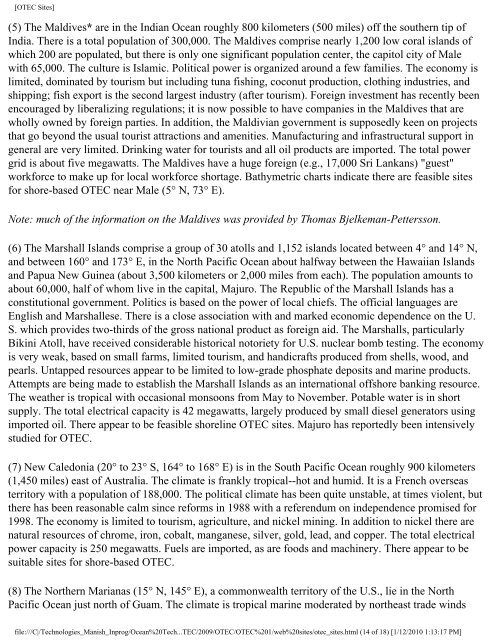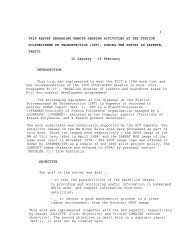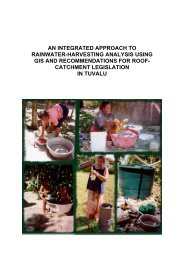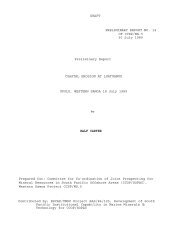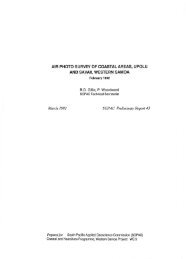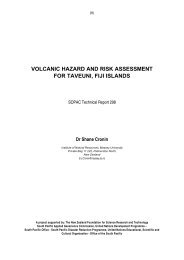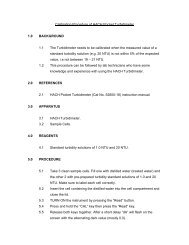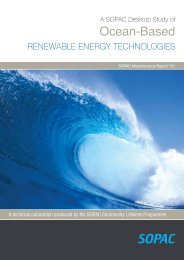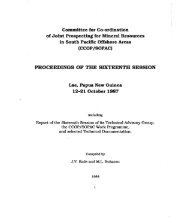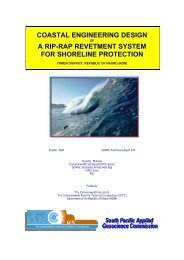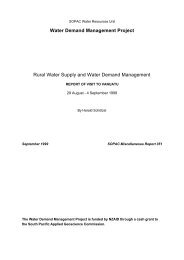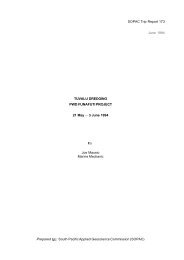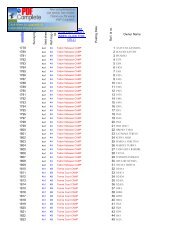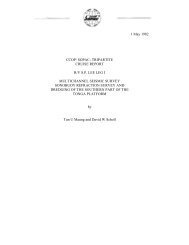OTEC Site Criteria - Up To
OTEC Site Criteria - Up To
OTEC Site Criteria - Up To
Create successful ePaper yourself
Turn your PDF publications into a flip-book with our unique Google optimized e-Paper software.
[<strong>OTEC</strong> <strong>Site</strong>s]<br />
(5) The Maldives* are in the Indian Ocean roughly 800 kilometers (500 miles) off the southern tip of<br />
India. There is a total population of 300,000. The Maldives comprise nearly 1,200 low coral islands of<br />
which 200 are populated, but there is only one significant population center, the capitol city of Male<br />
with 65,000. The culture is Islamic. Political power is organized around a few families. The economy is<br />
limited, dominated by tourism but including tuna fishing, coconut production, clothing industries, and<br />
shipping; fish export is the second largest industry (after tourism). Foreign investment has recently been<br />
encouraged by liberalizing regulations; it is now possible to have companies in the Maldives that are<br />
wholly owned by foreign parties. In addition, the Maldivian government is supposedly keen on projects<br />
that go beyond the usual tourist attractions and amenities. Manufacturing and infrastructural support in<br />
general are very limited. Drinking water for tourists and all oil products are imported. The total power<br />
grid is about five megawatts. The Maldives have a huge foreign (e.g., 17,000 Sri Lankans) "guest"<br />
workforce to make up for local workforce shortage. Bathymetric charts indicate there are feasible sites<br />
for shore-based <strong>OTEC</strong> near Male (5° N, 73° E).<br />
Note: much of the information on the Maldives was provided by Thomas Bjelkeman-Pettersson.<br />
(6) The Marshall Islands comprise a group of 30 atolls and 1,152 islands located between 4° and 14° N,<br />
and between 160° and 173° E, in the North Pacific Ocean about halfway between the Hawaiian Islands<br />
and Papua New Guinea (about 3,500 kilometers or 2,000 miles from each). The population amounts to<br />
about 60,000, half of whom live in the capital, Majuro. The Republic of the Marshall Islands has a<br />
constitutional government. Politics is based on the power of local chiefs. The official languages are<br />
English and Marshallese. There is a close association with and marked economic dependence on the U.<br />
S. which provides two-thirds of the gross national product as foreign aid. The Marshalls, particularly<br />
Bikini Atoll, have received considerable historical notoriety for U.S. nuclear bomb testing. The economy<br />
is very weak, based on small farms, limited tourism, and handicrafts produced from shells, wood, and<br />
pearls. Untapped resources appear to be limited to low-grade phosphate deposits and marine products.<br />
Attempts are being made to establish the Marshall Islands as an international offshore banking resource.<br />
The weather is tropical with occasional monsoons from May to November. Potable water is in short<br />
supply. The total electrical capacity is 42 megawatts, largely produced by small diesel generators using<br />
imported oil. There appear to be feasible shoreline <strong>OTEC</strong> sites. Majuro has reportedly been intensively<br />
studied for <strong>OTEC</strong>.<br />
(7) New Caledonia (20° to 23° S, 164° to 168° E) is in the South Pacific Ocean roughly 900 kilometers<br />
(1,450 miles) east of Australia. The climate is frankly tropical--hot and humid. It is a French overseas<br />
territory with a population of 188,000. The political climate has been quite unstable, at times violent, but<br />
there has been reasonable calm since reforms in 1988 with a referendum on independence promised for<br />
1998. The economy is limited to tourism, agriculture, and nickel mining. In addition to nickel there are<br />
natural resources of chrome, iron, cobalt, manganese, silver, gold, lead, and copper. The total electrical<br />
power capacity is 250 megawatts. Fuels are imported, as are foods and machinery. There appear to be<br />
suitable sites for shore-based <strong>OTEC</strong>.<br />
(8) The Northern Marianas (15° N, 145° E), a commonwealth territory of the U.S., lie in the North<br />
Pacific Ocean just north of Guam. The climate is tropical marine moderated by northeast trade winds<br />
file:///C|/Technologies_Manish_Inprog/Ocean%20Tech...TEC/2009/<strong>OTEC</strong>/<strong>OTEC</strong>%201/web%20sites/otec_sites.html (14 of 18) [1/12/2010 1:13:17 PM]


